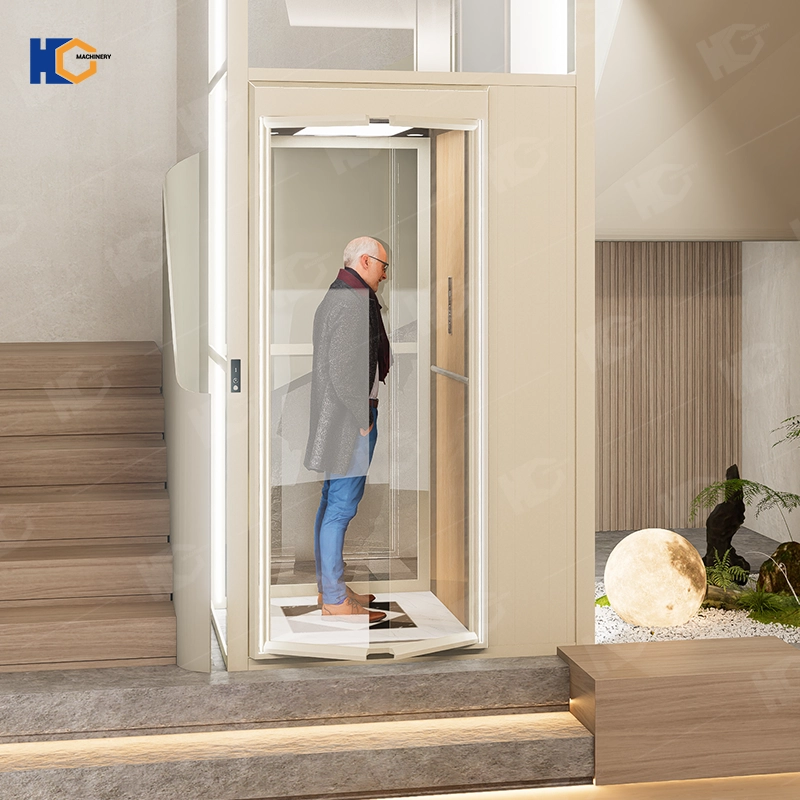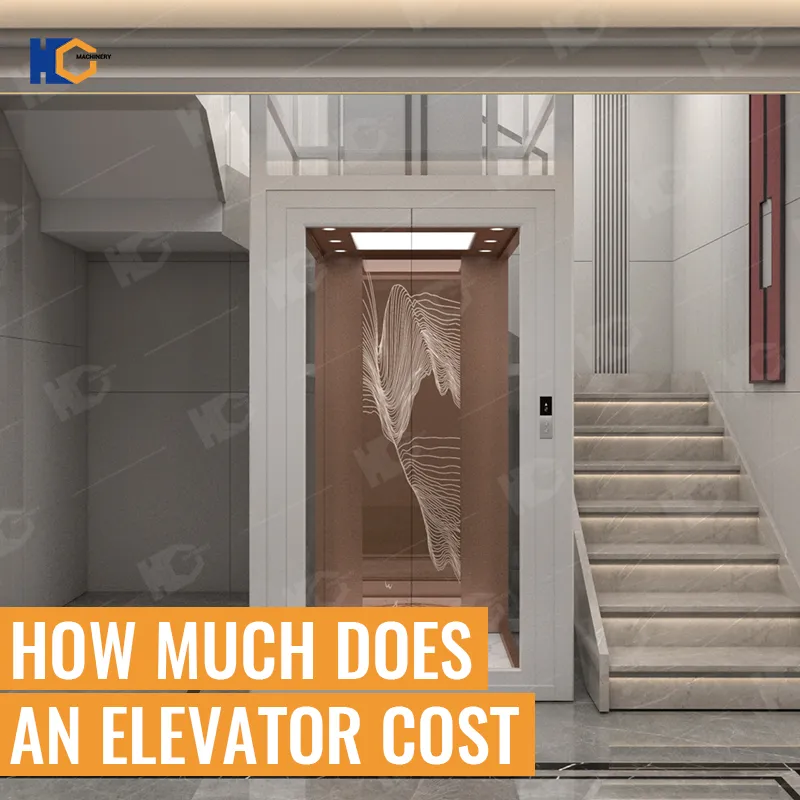Family Small Capsule Elevators: Prices, Specifications and Selection Guide for the Indian Market
1. What is a small capsule elevator for families?
The Small Capsule Lift for Home is a vertical transportation device designed for residential use, mainly used for villas, duplex floors, apartments, or old house renovations. Compared with traditional elevators, it has core advantages such as small size, flexible installation, and low energy consumption. The emergence of this kind of equipment perfectly solves the vertical transportation problem caused by the complex structure of stairs or the narrow spacing of floors in Indian homes. Compared with traditional elevators, it has the following characteristics:
1. Small size
The car size of the capsule elevator is usually within 1.2 m× 1.2 m× 2.3 m, similar to the size of a telephone booth, suitable for narrow elevator shafts or stairwells.
2. Flexible installation:
No need for a large machine room, it can be installed in the middle of stairs or against a wall, even suitable for old buildings.
3. Low energy consumption and quietness:
Permanent magnet synchronous motor (PMSM) and lightweight design are adopted, the energy consumption is only 30% of that of traditional elevators, and the operating noise is less than 50 decibels.
4. High safety:
Equipped with intelligent systems such as emergency braking, overload protection, and door opening and keeping detection.
Applicable Scenarios:
Multi-storey dwellings for families who are inconvenient to go up and down the stairs
Vertical traffic optimization for villas or duplexes
Renovation project of installing elevators in old houses
920820.webp)
The size and price of mainstream household capsule elevators
According to the Indian national standard (IS 14665), home elevators need to meet mandatory requirements such as shaft depth ≥ 1.2 meters and car area ≤ 1.44 square meters, which directly determines the standardized size and pricing logic of the product.
Standard size and capacity
Model | Car dimensions (length×width× height). | Load capacity | Applicable hoistway size |
Economical | 1.0m×1.0m×2.2m | 250 kg | 1.2m×1.2m |
Standard | 1.1m×1.1m×2.3m | 375 kg | 1.3m×1.3m |
Luxury | 1.2m×1.2m×2.4m | 500 kg | 1.4m×1.4m |
Note: The Indian National Standard (IS 14665) stipulates that at least 5cm safety clearance should be reserved for home elevator shafts. It is important to note that these basic parameters only reflect the prevailing industry standards, and should be selected in conjunction with the structural characteristics of staircases that are common in Indian households, such as the diameter limit of the shaft of the spiral staircase or the load-bearing capacity of older buildings.
2. Price range (latest data for 2025)
type | Indian Rupee (INR). | US Dollar (USD). | Core configuration |
Basic (hydraulic) | 150,000–200,000 | 1,800–2,400 | Hydraulically driven, stainless steel car, basic safety features |
Standard (Traction) | 250,000–350,000 | 3,000–4,200 | Permanent magnet motor, LED lighting, intelligent call panel |
Custom-made | 400,000 – 600,000+ | 4,800–7,200+ | Carbon fiber material, glass car, high-speed operation |
Price Difference Factor:
Drive mode: Hydraulic elevators are about 30% cheaper than traction types, but the maintenance cost is higher.
Material: mirror stainless steel or carbon fiber car premium 20%-50%.
Additional functions: such as face recognition, remote APP control, etc., require an additional 15%-20% fee.
The price difference is not only due to the hardware configuration, but also to the cost of installation across India. For example, the overall installation cost in Mumbai may increase by Rs. 5-80,000 due to labor costs being 20% higher than in Delhi.
3. Customized specifications and cost analysis
Based on the pricing logic of the above-mentioned standardized products, home users often need to make personalized adjustments according to the actual living environment, which involves customized services. According to a survey conducted by the Maharashtra State Building Association, more than 60% of orders require at least one customised change.
Common customization needs and price increments
Customized projects | Price Impact | example |
Material upgrades | +20%–50% | Carbon Fiber Car (Basic + INR 450,000) |
The load is lifted to 630 kg | +30% | Suitable for mixed-use commercial and residential |
Ultra-high-speed operation (1.75m/s) | +25% | The depth of the hoistway needs to be increased by 15% |
Luxurious interiors (marble floors) | +15%–20% | Attach wood grain panels or art glass |
Smart home integration | +20%–30% | Amazon Alexa/Google Home |
In the case of a villa project in Gujarat, the owner chose a carbon fibre car (+Rs.450,000) while paying an additional Rs.200,000 to reinforce the existing wooden staircase, revealing the complexity of the hidden costs of a bespoke project.
2. Customization process and precautions
1. Demand communication: clear load, speed, car style (modern/retro).
2. Space measurement: Stairwell structure drawings are required to confirm the size of the hoistway and the turning radius.
3. Approval & Installation: Some Indian states (e.g., Maharashtra) require a structural safety certificate with an installation period of about 7–15 days.
When customization needs involve structural modifications, the importance of professional evaluation becomes even more prominent. According to a recent report by the Consumers Association of India (CAC), 38% of custom orders that were not professionally measured resulted in installation failure due to insufficient hoistway load-bearing.
280372.webp)
4. Procurement suggestions and 10 practical tips
With a wide variety of products on the market, consumers need a systematic decision-making framework to avoid risks. The following recommendations incorporate the authoritative guidelines of the Elevator Installation Association of India (IEA) with real user feedback.
5 questions to ask before purchasing
Hoistway suitability: Can the existing staircase be retrofitted? Do I need to remove the walls?
Maintenance cost: The annual maintenance cost is about 3%-5% of the total price, and the hydraulic elevator is higher.
Warranty: The core components (motor, wire rope) are guaranteed for at least 3 years.
Contingency plan: Is backup power or mechanical release activated in the event of a power outage?
Local service: Preference is given to brands that have repair stations in India (e.g. Pride Elevators).
Of particular concern is the issue of maintenance costs – a user case shows that owners who choose hydraulic elevators spend Rs.27,000 more on maintenance than traction users in the fifth year, which confirms the importance of the choice of technical route in the initial purchase phase.
2. 10 pit-avoidance tips
1. Avoid the low-price trap: Elevators below Rs 150 lakh may use inferior motors.
2. Site visit to the factory: check the welding process and car sheet metal thickness.
3. Test run required: Test acceleration/deceleration smoothness, noise ≤ 50 decibels.
4. Confirm hoistway reinforcement: old buildings need to be supported by additional steel beams.
5. Contract details: clarify whether transportation, installation, and commissioning are included in the quotation.
6. Reserved access opening: 60cm of space ≥ the top of the hoistway should be left for maintenance. Regarding the reservation of manholes, the Uttar Pradesh Bureau of Technical Standards (BIS) has clearly stipulated that old buildings with less than 60cm of hoistway roof space must be designed with a detachable car roof, but such a scheme will increase maintenance costs by 15%.
7. Modular design: easy to upgrade and expand in the future.
8. Focus on energy consumption certification: 5-star BEE certified products are preferred.
9. Insurance coverage: Purchase elevator property insurance to prevent accidental damage.
10. Community approval: Condominium projects require written consent from the owners' committee.
826293.webp)
Top 10 Frequently Asked Questions (FAQs) about Family Small Capsule Elevators
After completing the purchase decision, users are often faced with specific questions in practice. The following FAQs are based on the high-frequency questions of the Consumer Complaint Database (CCPD) in India, covering the pain points of the whole life cycle from installation to maintenance.
1. How long does it take to install?
A: The standard model takes about 7–10 days, and the customized model takes 15–20 days due to factory production. Compared with the average installation period of 21 days for traditional elevators, the 7-10 day advantage of capsule elevators is mainly due to the modular design, but it should be noted that the rainy season (June-September) may lead to a 30% extension of the construction period.
2. How much does the maintenance cost cost per year?
A: The average annual maintenance fee is Rs 5,000–8,000 including lubrication, wire rope inspection, etc. The data comes from the Elevator Services Alliance of India (CESA) 2024 industry report, which includes a sample of 7 major cities such as Delhi and Bangalore, but Mumbai's humid climate could lead to a 20% increase in maintenance frequency.
3. Is it noisy during operation?
A: The noise level of a high-quality elevator ≤ 50 decibels (equivalent to the library environment).
4. How is security guaranteed?
A: Standard anti-pinch door, overspeed protection, emergency call device, in line with IS 14665 standard.
5. How many floors is it suitable for?
A: Usually covers 1–5 floors, with a maximum lifting height of 15 meters (about 5 floors).
6. Do I need a separate data center?
Answer: The traction elevator does not need a machine room, and the hydraulic elevator requires 1m² space.
7. Is the power consumption high?
Answer: The daily power consumption of the 1.0kW motor is about 0.8 kWh, and the standby power consumption is negligible.
8. How long is the warranty period?
A: The warranty for the whole machine is 2-3 years, and the motor and control system are extended to 5 years.
9. Can an old house be retrofitted?
Answer: It is necessary to evaluate the width of the staircase ≥ 90cm, and the usable space of the hoistway ≥ 1.2m².
10. What is the difference with a screw elevator?
Answer: Capsule elevators are more space-saving, but screw elevators do not need hoistways and are suitable for very small apartments.
303055.webp)
Summary and recommendations for action
Home small capsule elevators are becoming a popular choice for the Indian middle class to improve their living experience. It is advisable to give preference to brands that provide a one-stop shop for design-installation-maintenance (e.g. Schindler India) and specify the delivery criteria in the contract. For those on a budget, consider used refurbished models (30–40% less expensive than new), but make sure the refurbishment is ISO certified.
Final Decision checklist:
✅ Measure hoistways and obtain structural safety reports
✅ Compare quotations
✅ from more than 3 suppliers Confirm the brand of
✅ accessories (e.g. buttons, lighting) Reserve 10% Budgets are used for unforeseen expenses
Through rational selection and professional installation, home capsule elevators will significantly improve the convenience and property value of multi-storey residences.
Through the systematic analysis of this paper, we have comprehensively analyzed the core elements of the home small capsule elevator. For Indian families, this is not only a vertical transportation solution, but also a strategic investment to improve the mobility and quality of living in real estate.
Against the backdrop of accelerating urbanization in India, the home elevator market has grown at an average annual rate of 12.3% (FICCI 2024). By seizing this trend through scientific decision-making, you will create lasting life value for your family.
428.webp)




790.webp)